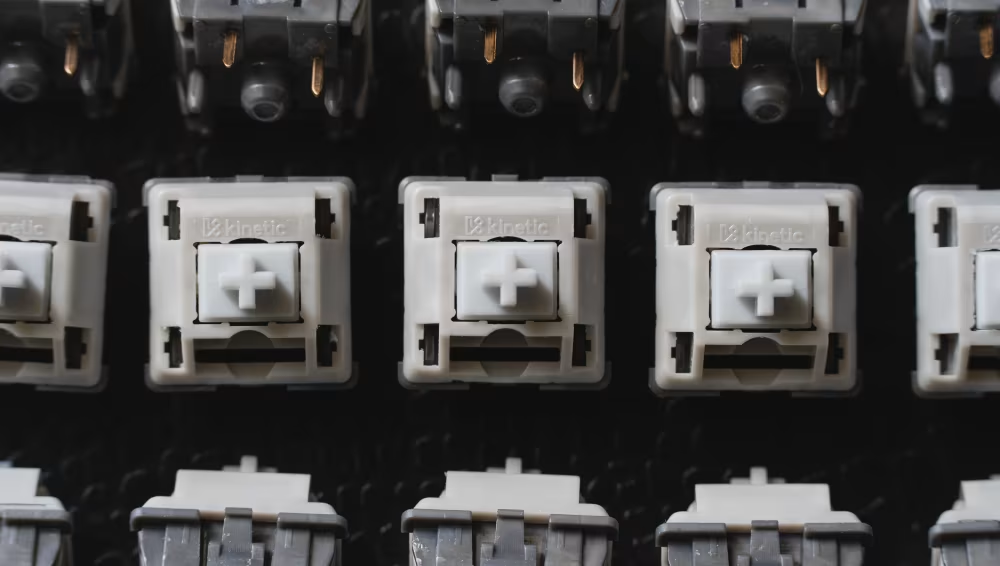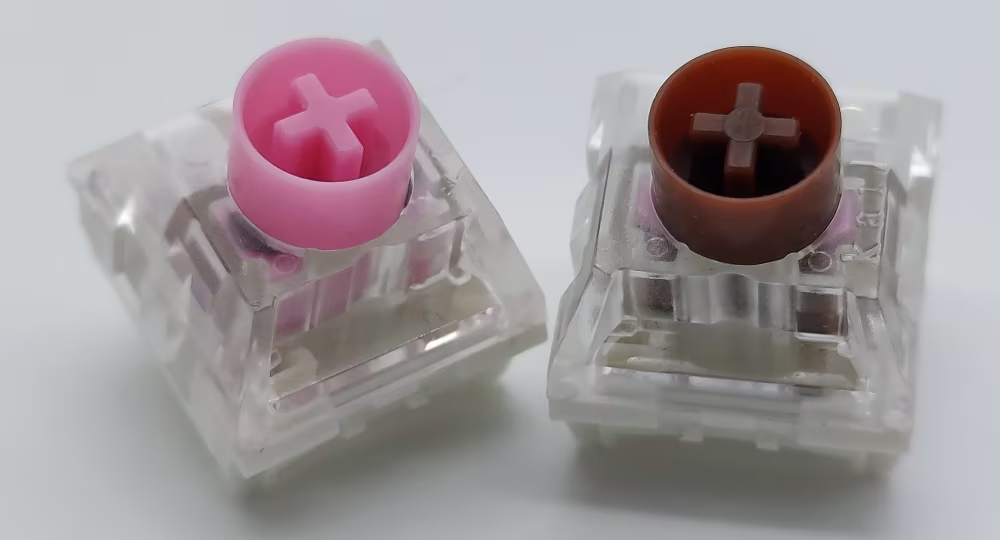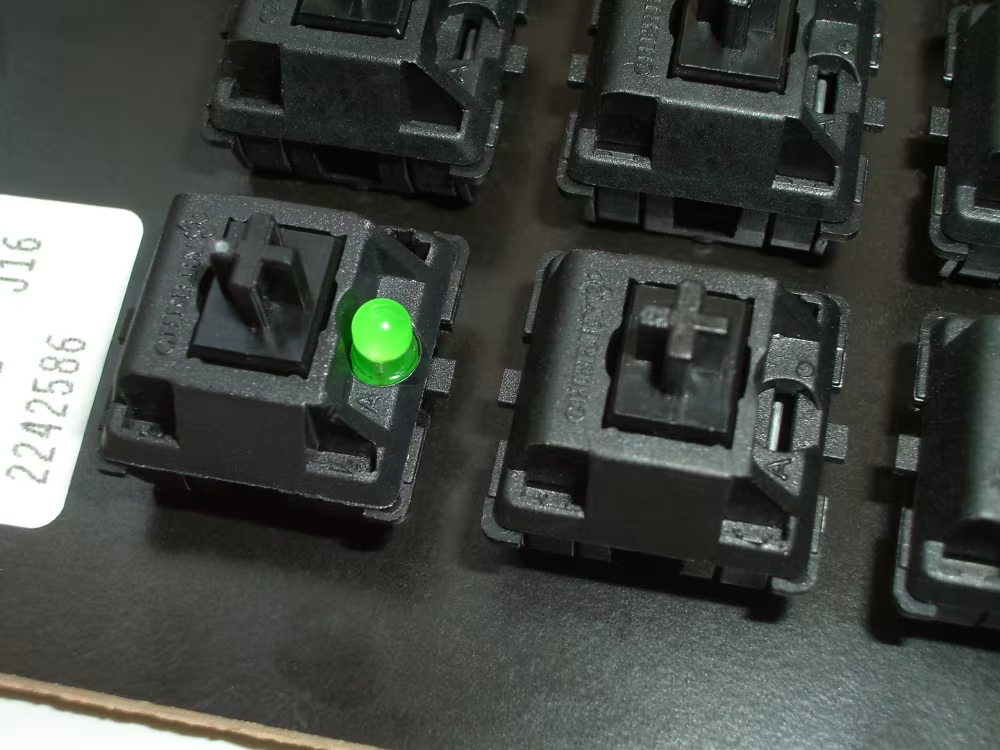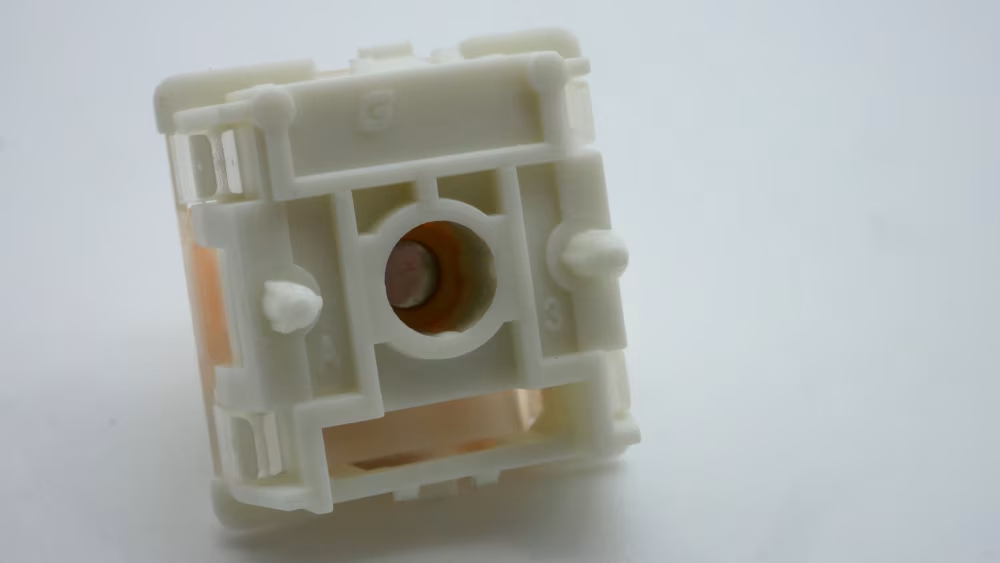

Kinetic Labs Husky Linear Switches
As a content creator dedicated to documenting as much about switches as I possibly can, I typically will set small ‘sub-goals’ for myself to help keep the process interesting and fresh after nearly 5 years of writing. Lately, one of my personal goals has been focusing on trying to curb community-wide misinformation since there is, well, quite a lot of it to be had. While a decent amount of these beliefs can be traced back to singular tutorials posted on YouTube or TikTok about how to build a keyboard or what to look for in your boards, an even larger amount seems to just nebulously exist throughout the hobby in the form of personal anecdotes handed down from enthusiast to enthusiast over the years. For me, I can trace some of my original misguided beliefs back to a single friend in the hobby who started me off by saying, “just buy these switches†or “avoid that brand at all costs.†I imagine it’s probably the same for most of you as well.
While I don’t blame my buddy for sharing those incorrect claims, looking back now, I can see a sort of ‘telephone game’ in those phrases in which they’ve been passed down through so many people over the years that they’ve clearly warped outside of their original meanings. So, in order to try and help put an end to some of these beliefs and fulfill my own goal of getting it carved into stone, here are a few miscellaneous switch myths that have come up multiple times over the years that deserve to have their records set straight. (And make sure you don’t mess these up as you pass them along either!)
1. You can't lube Box switches


Kailh Box Pink and Box Silent Brown
Starting this list off is perhaps the single oldest piece of misinformation that I not only remember being told but also parroting myself back when I first started building keyboards: Kailh’s Box line of switches can’t be lubed. Even as I tried to dig back in time while writing this article to find the source of it, I have no clue where this claim originated from or even why it was thought that this was the case in the first place. If I had to take a guess, I imagine the reason that people felt they couldn’t or shouldn’t lube Box switches is out of fear that accidentally lubing the little actuation lever that connects the stems to the ‘boxed in’ leaves of the switches would gum them up and prevent them from actuating. However, the same claim could also be made about accidentally gumming up normal, MX-style leaves, and that is an issue that virtually nobody has ever had. So, in all reality, it’s perfectly safe to lube Box switch stems and springs, just so long as you lube lightly, test often, and don’t go overboard with it.
2. All switches benefit from being filmed and lubed
Given that switch films as they exist today weren’t really a thing when I first joined the hobby, this clearly can be traced back to a much more recent and still problematic string of clickbait keyboard-building videos. There is an extremely widespread belief among newer keyboard enthusiasts that the only way to truly build the best keyboard starts with first lubing and filming whatever switch it is that they’re going to use. This is simply not necessary. Both lubing and filming are switch modifications that came about as a way to compensate for deficiencies that stock switches had at the time. The use case of lube is fairly well understood here, with switches that are scratchy or have a textured feeling to their downstrokes being smoothed over with a thin application of a lubricant or grease at those plastic-on-plastic points of contact.
The use case of films, however, is not so obvious. The majority of people who believe they are a necessity assume that they’re just for the purpose of modifying switch sound when, in reality, films were designed to shore up loose top housings on switches. While it’s true that filming switches can impact their sound, trying to force films into switches with rock-solid tolerances only runs the risk of damaging them instead. If the switches you have for your board are smooth to your liking and/or don’t have any top housing wobble, you may not even need lube or films at all to have a great keyboard build.
3. You can visually tell the difference between modern, NOS, and vintage Cherry MX Blacks


MX Blacks in Board
Amongst those out there who resell switches on the aftermarket, Cherry MX Blacks have long been a favorite way to make a few extra bucks. The abundance of these switches in a wide range of keyboards made them out to be, at least at one point in time, impossibly easy to find, desolder, and sell with a markup through the slapped-on label of being ‘vintage’ or ‘NOS’. As times have changed and it's harder to find Cherry MX Black keyboards at E-waste facilities, many of those resellers have tried to squeeze the most money out of the aftermarket by claiming their random bag of MX Blacks they found in their closet are definitely “Vintage†because of a particular way that they look. Unfortunately, there is no definitive way to tell the age of a Cherry MX Black switch by visually inspecting it inside or out. (If you think that you can do this, you are wrong.) The only way to reliably know how old a set of Cherry MX Black switches is to know the board that they were harvested from and/or where they were purchased from.
4. There is a ‘best’ switch for gaming, typing, etc.
The belief that there is a superior switch type for a specific keyboard purpose seems to be one that follows people in from the outside of the hobby and lingers until they start digging in deeper. Many of these newcomers believe or have been told that typing or gaming, in particular, could benefit from certain switches that match some vaguely defined set of specifications that are never consistent from person to person. Irrespective of what any company or advertisements tell you from this day onwards, I want you to permanently etch into your brain that there is no best switch for any specific task. The best switches for your gaming or writing keyboard will always be the ones that you can afford, that you like, and that you feel comfortable using. There is no technology in switches that will be able to give you any competitive advantage in gaming or increase your WPM significantly while typing. Consider that if such things were possible, every business on the planet would have already invested in this technology for all of their workers long ago.
5. Since all MX-style switches are interchangeable, all Hall Effect ones are too.


Dual Rail Orange Bottom
Of all of these misguided pieces of advice on this list, this is certainly the newest belief, and I‘m not sure that it’s quite made it to ‘community-wide bad advice’ status yet. However, it has strong potential to. As I covered in my article on Kinetic Labs introducing Hall Effect switches, there’s a new type of switch making waves in the mechanical keyboard community lately that uses magnets rather than the common electric circuits of MX-style switches to register keystrokes. Since these new and unfamiliar types of switches look similar to MX-style switches in passing, many people are already jumping to conclusions and assuming that they can be swapped out for one another or with MX-style switches seamlessly. For one, this is already a bad starting point as Hall Effect switches require a special type of PCBs and PCB firmware in order to make them work, meaning that attempting to use traditional MX switches on a Hall Effect board won’t work.
However, this nuance goes even one level deeper. Since Hall Effect PCB firmware is specifically designed to detect a certain specific magnetic strength, not all HE switches will work well with all HE PCBs. A hypothetical Brand ‘A’ might have a switch with a magnet that is twice as strong as Brand ‘B’, and so if you were to try and put an ‘A’ switch in a ‘B’ board or a ‘B’ switch in an ‘A’ board, you’d end up having switches that misfire at best and won’t work at all at worst. So, if you’re going to go down the road of swapping Hall Effect switches in your new, cutting-edge keyboards, make sure to check to see if compatibility charts exist from the manufacturer of the PCB first, and don’t assume they work just like MX switches!
At the end of this list, I have to hope that I’ve at least corrected one piece of misinformation about switches that you’ve come to internalize over your months or years of being in the hobby. Much more deeply, though, I wish that you’ll take these newfound revelations and share them with your keyboard friends and/or pass the wisdom along to any newcomers you come across in the future. While trying to nip this misinformation in the bud certainly will help prevent it from spreading further in time, the most effective way is to make sure that the next generation of keyboard enthusiasts that come after us start off at a better, more well-understood place than we did. After all, that’s at least why I write documentation like this about switches. Speaking of that, consider learning some more about switches through some of my articles here on Kinetic Labs, such as ‘What Some Switch Marketing Terms Really Mean’ or ‘3 Tiers to Keyboard Switch Modding’.
Battery Energy Storage System (BESS) is a complex system that integrates multiple technologies and devices to store electrical energy in the form of chemical energy and release it for use when needed. The following is a detailed description of the purpose of the BESS class:
I. Basic definition
BESS is a system that uses lithium batteries, lead batteries, etc., as energy storage carriers to store electricity for a certain period of time and supply electricity when needed. The power provided by the system has functions such as smooth transition, peak cutting and valley filling, frequency regulating and voltage regulating, etc. It is of great significance to improve the stability, reliability and flexibility of the power grid.
Second, system composition
BESS mainly consists of the following parts:
Battery Array:
It is the core part of BESS and is used to store electrical energy. Common energy storage batteries include lithium-ion batteries, lead-acid batteries and so on.
The performance of the battery directly affects the efficiency and reliability of the entire energy storage system.
Battery Management System (BMS) :
Responsible for intelligent management and maintenance of each battery unit, prevent the battery from overcharging and overdischarging, and extend the service life of the battery.
Monitor the battery status, including voltage, current, temperature and other parameters, to ensure the safe operation of the battery pack.
Energy Storage converters (PCS) :
It is one of the key devices in BESS, responsible for converting direct current in the battery pack to alternating current, or alternating current to direct current, to meet the needs of different application scenarios.
PCS has the ability to control the flow of electric energy bidirectional, and can flexibly adjust the power and voltage of the grid.
Local controller:
Responsible for local control and management of BESS, including data collection, condition monitoring, fault diagnosis and other functions.
The local controller can also communicate with the external energy management system (EMS) to receive instructions and perform energy scheduling and power control.
Power distribution system:
Devices such as switches, circuit breakers, cables, etc. are included to connect BESS to the power grid or other loads.
Distribution systems need to ensure the safe transmission and distribution of electrical energy.
Auxiliary equipment:
Including temperature control system, fire protection system, lighting system, monitoring system and so on.
These devices are used to ensure the safe operation and routine maintenance of BESS.
3. Technical characteristics
High efficiency:
BESS has high energy conversion efficiency and charge and discharge efficiency, which can maximize the use of stored electrical energy.
Flexibility:
BESS can be flexibly configured and expanded according to actual requirements to adapt to different scales and scenarios.
Reliability:
With advanced BMS and PCS technology, BESS is able to ensure the safe operation and efficient utilization of battery packs and improve the reliability of the system.
Environmental protection:
BESS uses renewable energy for energy storage and power supply, reducing dependence on traditional energy sources and environmental pollution.
BESS Lifepo4 battery, solar power energy system, 3.2V lithium battery cell
Foshan Keylewatt Technology Co., LTD , https://www.keylewatt.com
